dimensions FIAT 500X 2019 Owner handbook (in English)
[x] Cancel search | Manufacturer: FIAT, Model Year: 2019, Model line: 500X, Model: FIAT 500X 2019Pages: 284, PDF Size: 8.33 MB
Page 47 of 284
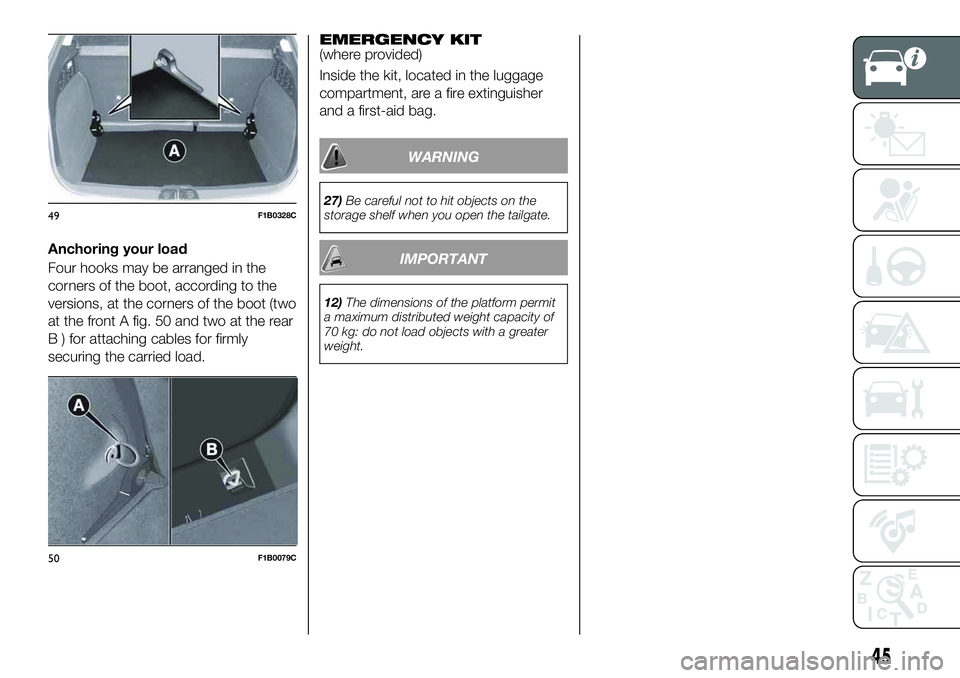
Anchoring your load
Four hooks may be arranged in the
corners of the boot, according to the
versions, at the corners of the boot (two
at the front A fig. 50 and two at the rear
B ) for attaching cables for firmly
securing the carried load.
EMERGENCY KIT(where provided)
Inside the kit, located in the luggage
compartment, are a fire extinguisher
and a first-aid bag.
WARNING
27)Be careful not to hit objects on the
storage shelf when you open the tailgate.
IMPORTANT
12)The dimensions of the platform permit
a maximum distributed weight capacity of
70 kg: do not load objects with a greater
weight.
49F1B0328C
50F1B0079C
45
Page 79 of 284
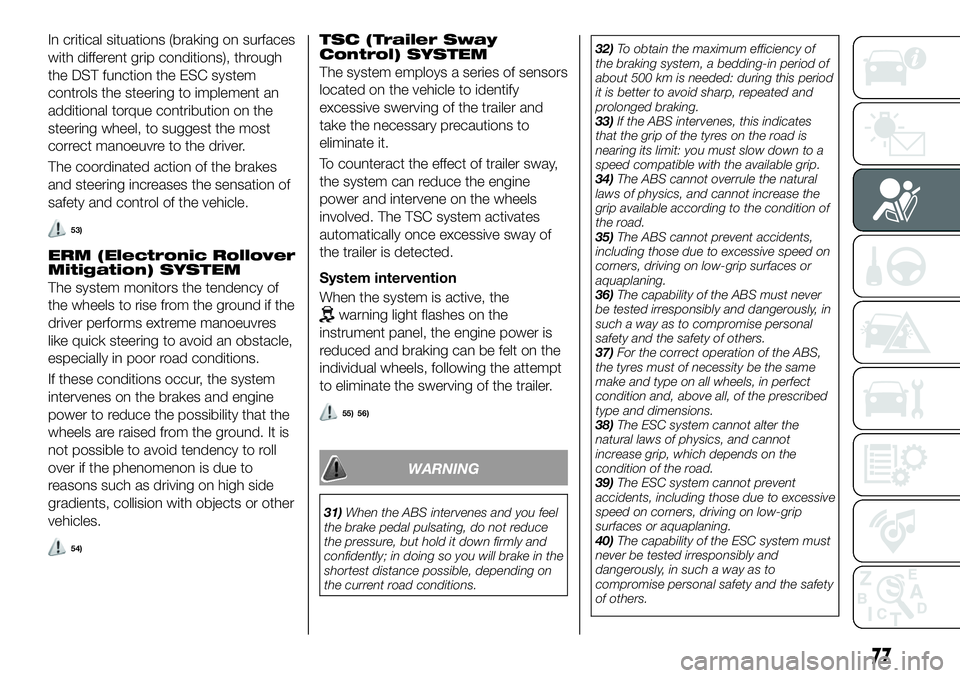
In critical situations (braking on surfaces
with different grip conditions), through
the DST function the ESC system
controls the steering to implement an
additional torque contribution on the
steering wheel, to suggest the most
correct manoeuvre to the driver.
The coordinated action of the brakes
and steering increases the sensation of
safety and control of the vehicle.
53)
ERM (Electronic Rollover
Mitigation) SYSTEM
The system monitors the tendency of
the wheels to rise from the ground if the
driver performs extreme manoeuvres
like quick steering to avoid an obstacle,
especially in poor road conditions.
If these conditions occur, the system
intervenes on the brakes and engine
power to reduce the possibility that the
wheels are raised from the ground. It is
not possible to avoid tendency to roll
over if the phenomenon is due to
reasons such as driving on high side
gradients, collision with objects or other
vehicles.
54)
TSC (Trailer Sway
Control) SYSTEM
The system employs a series of sensors
located on the vehicle to identify
excessive swerving of the trailer and
take the necessary precautions to
eliminate it.
To counteract the effect of trailer sway,
the system can reduce the engine
power and intervene on the wheels
involved. The TSC system activates
automatically once excessive sway of
the trailer is detected.
System intervention
When the system is active, the
warning light flashes on the
instrument panel, the engine power is
reduced and braking can be felt on the
individual wheels, following the attempt
to eliminate the swerving of the trailer.
55) 56)
WARNING
31)When the ABS intervenes and you feel
the brake pedal pulsating, do not reduce
the pressure, but hold it down firmly and
confidently; in doing so you will brake in the
shortest distance possible, depending on
the current road conditions.32)To obtain the maximum efficiency of
the braking system, a bedding-in period of
about 500 km is needed: during this period
it is better to avoid sharp, repeated and
prolonged braking.
33)If the ABS intervenes, this indicates
that the grip of the tyres on the road is
nearing its limit: you must slow down to a
speed compatible with the available grip.
34)The ABS cannot overrule the natural
laws of physics, and cannot increase the
grip available according to the condition of
the road.
35)The ABS cannot prevent accidents,
including those due to excessive speed on
corners, driving on low-grip surfaces or
aquaplaning.
36)The capability of the ABS must never
be tested irresponsibly and dangerously, in
such a way as to compromise personal
safety and the safety of others.
37)For the correct operation of the ABS,
the tyres must of necessity be the same
make and type on all wheels, in perfect
condition and, above all, of the prescribed
type and dimensions.
38)The ESC system cannot alter the
natural laws of physics, and cannot
increase grip, which depends on the
condition of the road.
39)The ESC system cannot prevent
accidents, including those due to excessive
speed on corners, driving on low-grip
surfaces or aquaplaning.
40)The capability of the ESC system must
never be tested irresponsibly and
dangerously, in such a way as to
compromise personal safety and the safety
of others.
77
Page 80 of 284

41)For the correct operation of the ESC
system, the tyres must necessarily be of
the same make and type on all wheels, in
perfect condition and, above all, of the
prescribed type and size.
42)ESC performance features must not
induce the driver to take unnecessary or
unwarranted risks. Your driving style must
always be suited to the road conditions,
visibility and traffic. The driver is, in any
case, responsible for safe driving.
43)For the correct operation of the TC
system, the tyres must of necessity be the
same make and type on all wheels, in
perfect condition and, above all, of the
prescribed type and dimensions.
44)TC performance features must not
induce the driver to take unnecessary or
unwarranted risks. Your driving style must
always be suited to the road conditions,
visibility and traffic. The driver is, in any
case, responsible for safe driving.
45)The TC system cannot overrule the
natural laws of physics, and cannot
increase the grip available according to the
condition of the road.
46)The TC system cannot prevent
accidents, including those due to excessive
speed on corners, driving on low-grip
surfaces or aquaplaning.
47)The capability of the TC must never be
tested irresponsibly and dangerously, in
such a way as to compromise personal
safety and the safety of others.
48)The PBA system cannot overrule the
natural laws of physics, and cannot
increase the grip available according to the
condition of the road.49)The PBA system cannot prevent
accidents, including those due to excessive
speed on corners, driving on low-grip
surfaces or aquaplaning.
50)The capability of the PBA system must
never be tested irresponsibly and
dangerously, in such a way as to
compromise the safety of the driver, the
other occupants of the vehicle or any other
road user.
51)The Hill Hold Control system is not a
parking brake; therefore, never leave the
vehicle without having engaged the electric
parking brake, turned the engine off and
engaged first gear, so that it is parked in
safe conditions (for further information read
the "Parking" paragraph in the "Starting
and driving" chapter).
52)There may be situations on small
gradients (less than 8%), with vehicle
laden, in which the Hill Hold Control system
may not activate, causing a slight reversing
motion and increasing the risk of collision
with another vehicle or object. The driver is,
in any case, responsible for safe driving.
53)DST is an aid for driving and does not
relieve the driver of responsibility for driving
the vehicle.
54)The performance of a vehicle with ERM
must never be tested in imprudent or
dangerous ways, with the possibility of
putting the safety of the driver or other
people at risk.
55)When towing trailers, the utmost
caution at the wheel is recommended.
Never exceed the maximum permitted
loads (see the description in the "Weights"
paragraph in the "Technical Specifications"
chapter).56)The TSC system cannot prevent
swerving for all trailers. If the system
activates during driving, reduce the speed,
stop the vehicle in a safe place and arrange
the load correctly to prevent the trailer from
swerving.
78
SAFETY
Page 86 of 284

Driving in special conditions
In certain driving conditions, such as,
for example:
driving close to a bend;
vehicles with small dimensions
and/or not aligned in the driving lane;
lane change by other vehicles;
vehicles travelling at right angles to
the vehicle.
system intervention might be
unexpected or delayed. The driver must
therefore be very careful, keeping
control of the vehicle to drive in
complete safety.
IMPORTANT NOTE In particularly
complex traffic conditions, the driver
can deactivate the system through the
Uconnect™system.
Driving close to a bend
When entering or leaving a wide bend,
the system may detect a vehicle that is
in front of you, but that is not driving in
the same lane fig. 59. In cases such as
these, the system may intervene.Vehicles with small dimensions
and/or not aligned in the driving
lane
The system cannot detect cars in front
of you but outside the range of the
radar sensor and may therefore not
react in the presence of small cars,
such as bicycles or motorcycles fig. 60.Lane change by other vehicles
Vehicles suddenly changing lane,
entering the same lane as your car and
within the radar sensor’s operating
range, may cause the system to
intervene fig. 61.
Vehicles travelling at right angles to
the vehicle
The system could temporarily react to a
vehicle that is passing through the radar
sensor’s operating range at right angles
fig. 62.
59F1B0713
60F1B0714
61F1B0715
84
SAFETY
Page 210 of 284
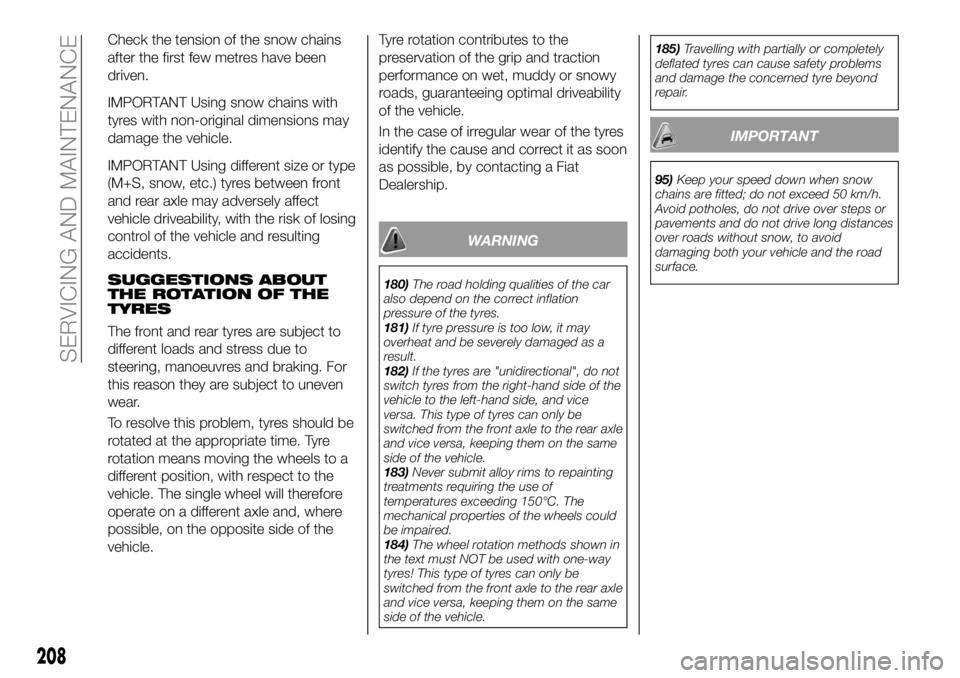
Check the tension of the snow chains
after the first few metres have been
driven.
IMPORTANT Using snow chains with
tyres with non-original dimensions may
damage the vehicle.
IMPORTANT Using different size or type
(M+S, snow, etc.) tyres between front
and rear axle may adversely affect
vehicle driveability, with the risk of losing
control of the vehicle and resulting
accidents.
SUGGESTIONS ABOUT
THE ROTATION OF THE
TYRES
The front and rear tyres are subject to
different loads and stress due to
steering, manoeuvres and braking. For
this reason they are subject to uneven
wear.
To resolve this problem, tyres should be
rotated at the appropriate time. Tyre
rotation means moving the wheels to a
different position, with respect to the
vehicle. The single wheel will therefore
operate on a different axle and, where
possible, on the opposite side of the
vehicle.Tyre rotation contributes to the
preservation of the grip and traction
performance on wet, muddy or snowy
roads, guaranteeing optimal driveability
of the vehicle.
In the case of irregular wear of the tyres
identify the cause and correct it as soon
as possible, by contacting a Fiat
Dealership.
WARNING
180)The road holding qualities of the car
also depend on the correct inflation
pressure of the tyres.
181)If tyre pressure is too low, it may
overheat and be severely damaged as a
result.
182)If the tyres are "unidirectional", do not
switch tyres from the right-hand side of the
vehicle to the left-hand side, and vice
versa. This type of tyres can only be
switched from the front axle to the rear axle
and vice versa, keeping them on the same
side of the vehicle.
183)Never submit alloy rims to repainting
treatments requiring the use of
temperatures exceeding 150°C. The
mechanical properties of the wheels could
be impaired.
184)The wheel rotation methods shown in
the text must NOT be used with one-way
tyres! This type of tyres can only be
switched from the front axle to the rear axle
and vice versa, keeping them on the same
side of the vehicle.185)Travelling with partially or completely
deflated tyres can cause safety problems
and damage the concerned tyre beyond
repair.
IMPORTANT
95)Keep your speed down when snow
chains are fitted; do not exceed 50 km/h.
Avoid potholes, do not drive over steps or
pavements and do not drive long distances
over roads without snow, to avoid
damaging both your vehicle and the road
surface.
208
SERVICING AND MAINTENANCE
Page 214 of 284

TECHNICAL SPECIFICATIONS
Everything you may find useful for
understanding how your vehicle is
made and works is contained in this
chapter and illustrated with data, tables
and graphics. For the enthusiasts and
the technician, but also just for those
who want to know every detail of their
vehicle.
IDENTIFICATION DATA.........213
ENGINE..................214
WHEELS.................217
DIMENSIONS..............219
WEIGHTS.................221
SUPPLIES................225
FLUIDS AND LUBRICANTS......230
PERFORMANCE............234
FUEL CONSUMPTION - CO
EMISSIONS................235
PRESCRIPTIONS FOR HANDLING
THE CAR AT THE END OF ITS
LIFE....................236
212
TECHNICAL SPECIFICATIONS
2
Page 221 of 284
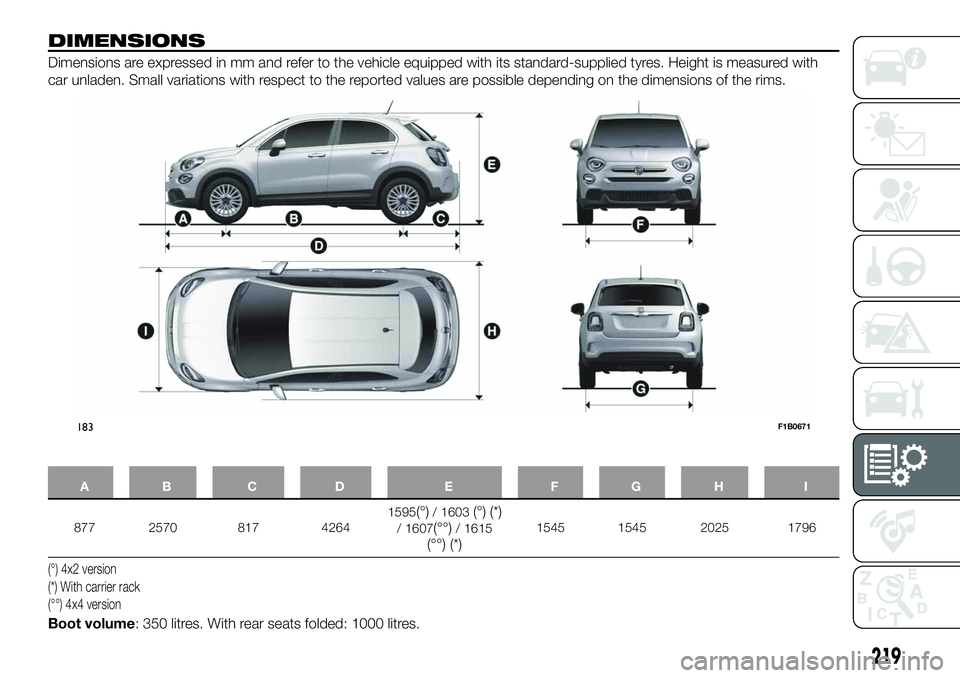
DIMENSIONS
Dimensions are expressed in mm and refer to the vehicle equipped with its standard-supplied tyres. Height is measured with
car unladen. Small variations with respect to the reported values are possible depending on the dimensions of the rims.
AB C D E FGH I
877 2570 817 42641595(°)/ 1603(°) (*)/ 1607(°°)/ 1615(°°) (*)
1545 1545 2025 1796
(°) 4x2 version
(*) With carrier rack
(°°) 4x4 version
Boot volume: 350 litres. With rear seats folded: 1000 litres.
183F1B0671
219
Page 222 of 284

Dimensions are expressed in mm and refer to the vehicle equipped with its standard-supplied tyres. Height is measured with
car unladen. Small variations with respect to the reported values are possible depending on the dimensions of the rims.
AB C D E FGH I
898 2570 801 42691595(°)/ 1603(°) (*)/ 1607(°°)/ 1615(°°) (*)
1545 1545 2025 1796
(°) 4x2 version
(*) With carrier rack
(°°) 4x4 version
Boot volume: 350 litres. With rear seats folded: 1000 litres.
184F1B0672
220
TECHNICAL SPECIFICATIONS
Page 279 of 284
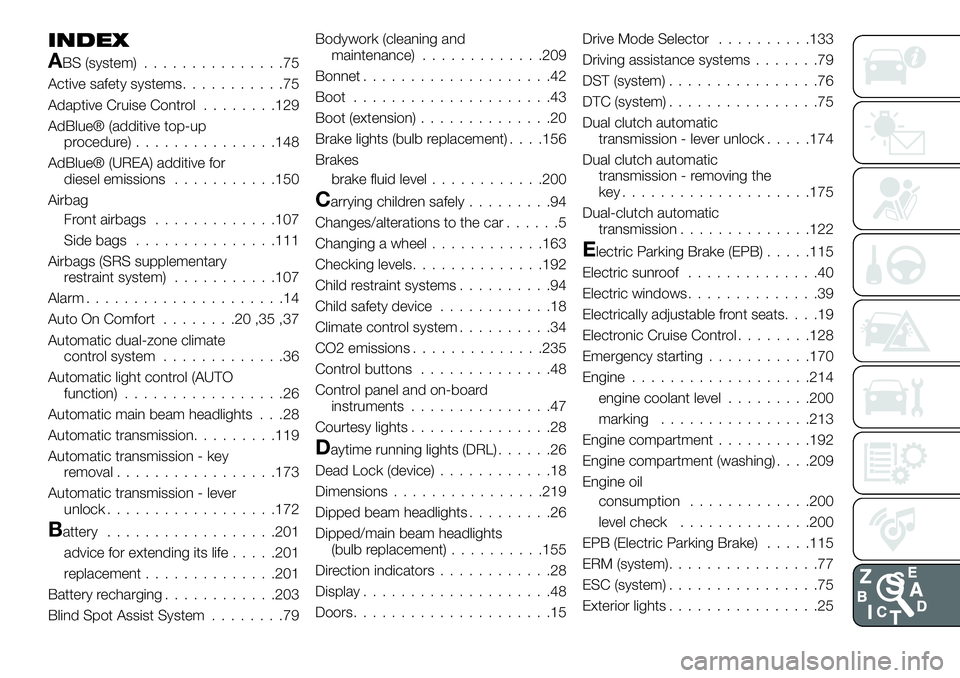
INDEX
ABS (system)...............75
Active safety systems...........75
Adaptive Cruise Control........129
AdBlue® (additive top-up
procedure)...............148
AdBlue® (UREA) additive for
diesel emissions...........150
Airbag
Front airbags.............107
Side bags...............111
Airbags (SRS supplementary
restraint system)...........107
Alarm.....................14
Auto On Comfort........20,35,37
Automatic dual-zone climate
control system.............36
Automatic light control (AUTO
function).................26
Automatic main beam headlights . . .28
Automatic transmission.........119
Automatic transmission - key
removal.................173
Automatic transmission - lever
unlock..................172
Battery..................201
advice for extending its life.....201
replacement..............201
Battery recharging............203
Blind Spot Assist System........79Bodywork (cleaning and
maintenance).............209
Bonnet....................42
Boot.....................43
Boot (extension)..............20
Brake lights (bulb replacement). . . .156
Brakes
brake fluid level............200
Carrying children safely.........94
Changes/alterations to the car......5
Changing a wheel............163
Checking levels..............192
Child restraint systems..........94
Child safety device............18
Climate control system..........34
CO2 emissions..............235
Control buttons..............48
Control panel and on-board
instruments...............47
Courtesy lights...............28
Daytime running lights (DRL)......26
Dead Lock (device)............18
Dimensions................219
Dipped beam headlights.........26
Dipped/main beam headlights
(bulb replacement)..........155
Direction indicators............28
Display....................48
Doors.....................15Drive Mode Selector..........133
Driving assistance systems.......79
DST (system)................76
DTC (system)................75
Dual clutch automatic
transmission - lever unlock.....174
Dual clutch automatic
transmission - removing the
key....................175
Dual-clutch automatic
transmission..............122
Electric Parking Brake (EPB).....115
Electric sunroof..............40
Electric windows..............39
Electrically adjustable front seats....19
Electronic Cruise Control........128
Emergency starting...........170
Engine...................214
engine coolant level.........200
marking................213
Engine compartment..........192
Engine compartment (washing). . . .209
Engine oil
consumption.............200
level check..............200
EPB (Electric Parking Brake).....115
ERM (system)................77
ESC (system)................75
Exterior lights................25
Page 281 of 284
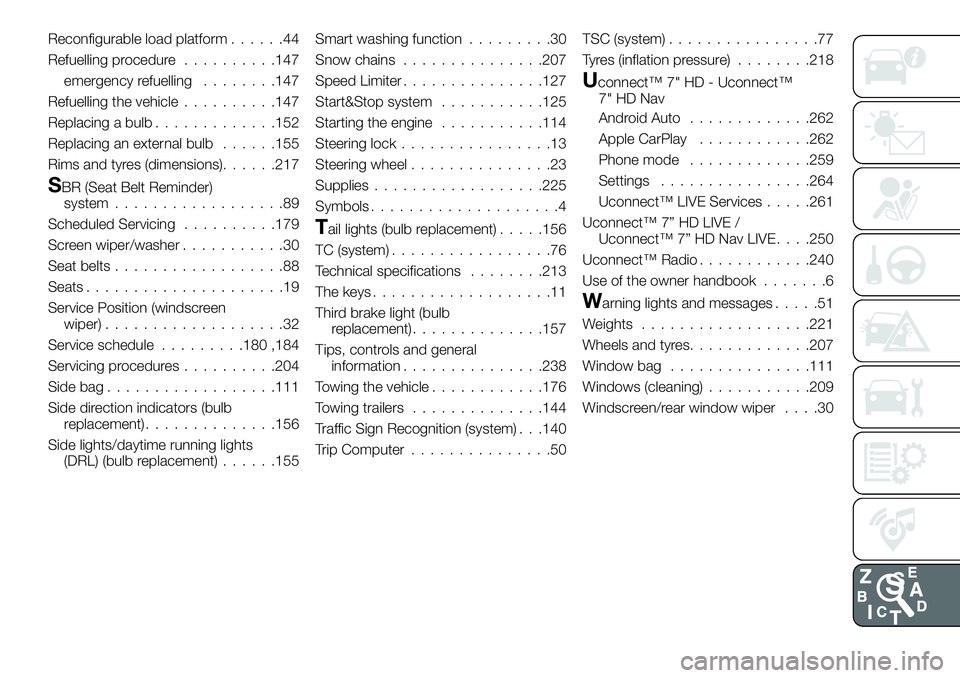
Reconfigurable load platform......44
Refuelling procedure..........147
emergency refuelling........147
Refuelling the vehicle..........147
Replacing a bulb.............152
Replacing an external bulb......155
Rims and tyres (dimensions)......217
SBR (Seat Belt Reminder)
system..................89
Scheduled Servicing..........179
Screen wiper/washer...........30
Seat belts..................88
Seats.....................19
Service Position (windscreen
wiper)...................32
Service schedule.........180 ,184
Servicing procedures..........204
Side bag..................111
Side direction indicators (bulb
replacement)..............156
Side lights/daytime running lights
(DRL) (bulb replacement)......155Smart washing function.........30
Snow chains...............207
Speed Limiter...............127
Start&Stop system...........125
Starting the engine...........114
Steering lock................13
Steering wheel...............23
Supplies..................225
Symbols....................4
Tail lights (bulb replacement).....156
TC (system).................76
Technical specifications........213
The keys...................11
Third brake light (bulb
replacement)..............157
Tips, controls and general
information...............238
Towing the vehicle............176
Towing trailers..............144
Traffic Sign Recognition (system) . . .140
Trip Computer...............50TSC (system)................77
Tyres (inflation pressure)........218
Uconnect™ 7" HD - Uconnect™
7" HD Nav
Android Auto.............262
Apple CarPlay............262
Phone mode.............259
Settings................264
Uconnect™ LIVE Services.....261
Uconnect™ 7” HD LIVE /
Uconnect™ 7” HD Nav LIVE. . . .250
Uconnect™ Radio............240
Use of the owner handbook.......6
Warning lights and messages.....51
Weights..................221
Wheels and tyres.............207
Window bag...............111
Windows (cleaning)...........209
Windscreen/rear window wiper....30